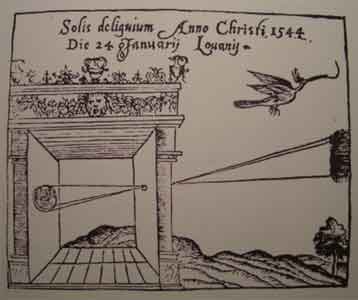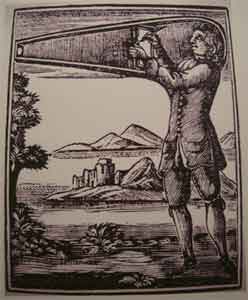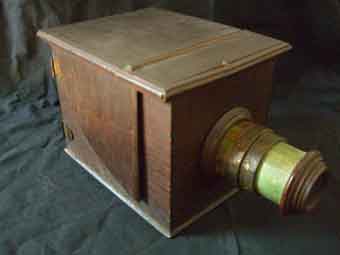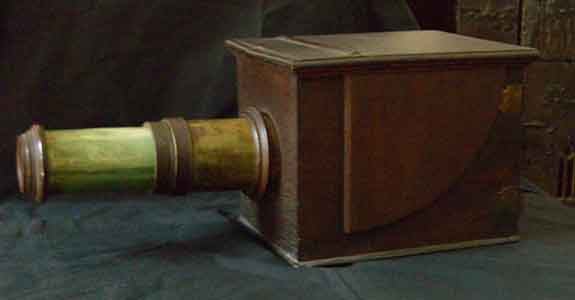1840 - 1860

Reinerus Frisius Gemma
Solis delignium Anno Christi 1544.
Die 24 Januarii Louanis
[See Sources and Notes]

Robert Hooke [designer]
Picture-box , 1694
[See Sources and Notes]
The photographic camera evolved from the portable camera obscura which had its beginnings in the late 17th century CE. As long ago as the 5th century BCE in China, Mo Ti and Chouang Chou saw an optical image which had been projected through a pinhole onto a screen in a dark place. They had witnessed a natural process that was central to the development of the camera obscura (L. ‘dark chamber’) which projects a two dimensional, inverted and laterally reversed, full colour representation of the exterior three-dimensional space. The additional dimension of time is involved, as any movement is projected in the image. In 1545 R. G. Frisius1 published an engraving of the safe observation of a solar eclipse using a camera obscura.
It was not until the 16th century CE that Daniel Barbaro2 gave a clear explanation for the use of the biconvex lens in the camera obscura but it is to Giovanni Battista della Porta3that historians usually give credit for the first detailed description of it. He writes about its use for both scientific and artistic purposes. As Surveyor for the City of London, Robert Hooke’s design4 of the camera obscura, which he named ‘Perspective Box’, enabled him to draw landscapes and buildings with greater accuracy than free hand-drawing. Its use for the artist is clear.
In 1778, William Storer patented a camera obscura which he called ‘The Accurate Delineator’. The Science Museum has one in its collection and in 1777 Horace Walpole, 4th earl of Orford, wrote in glowing terms to Reverend William West ‘ … it is invented within these eighteen months by William Storer, a Norfolk man, one of the modestest and humblest of beings. Sir Joshua Reynolds and West has gone mad with it, and it will be their own faults if they do not excel Rubens in light and shade…’. After royal patronage, Storer re-named his creation ‘Royal Accurate Delineator’.
The Strangers’ Hall Museum, Norwich has, in its collection, a variable focal length camera obscura which has an internal, plane mirror to reflect the image onto a ground glass screen and a drawer to carry the screen when in transit. It is of unknown provenance.
Mrs. Louisa Barwell, who, together with her husband John, organized the 1840 Norwich Polytechnic Exhibition, wrote a Companion Guide5 to the exhibition in which she mentioned a ‘camera obscura made by Mr. Gooch of Norwich who claims to be self-taught’ and‘… it is gratifying to find the artizans and operatives of our city engaged in these elevating pursuits.’
John Ninham, a Norwich painter and engraver, used a camera obscura as an optical aid when he made drawings of the Gates of Norwich in 1792-3, just before they were demolished.
Edward Alderson, a Norfolk circuit judge, used frequently to summer with his wife and their nine children in his mansion, Sparrow’s Nest, Lowestoft. Sometime in the mid-19th century he wrote6to his cousin Amelia Opie, in Norwich, 'Today I have been to see Mr.B--------'s camera obscura. The effect was really beautiful. The sea sparkled in the sun, and the waves moved, dashing themselves on the shore. The ships sailed on, and a steamer came by whilst we were looking at it. I was quite as much pleased at it as the children. M-------- was quite astonished to see a moving picture, and very much delighted when I sent the boys down to jump about on the grass bank,
which we saw them in the picture doing. I think this part of the exhibition pleased the most. But I liked the sparkling sun, shiny sea, and the moving ships far better...'
Sources and Notes
- Frisius, Rainer Gemma. Gemmae FrisiiDe radio astronomico & geometrico liber: in quo multa quae ad geographia, opticam, geometriam & astronomiam utilis sunt demonstrantur. Antverpiae 1545.
- Barbaro, Daniel. La pratica della perspectiva … Venetia: Camillo & Rutilio Borgominieri, 1568.
- Porta, Giovanni Battista della. Magiae Naturalis, sive de Miraculis Rerum Naturalium… Neapoli: Matthium Cancer, 1558.
- Derham, William [Ed.]. Philosophical experiments and observations of the late eminent Dr. Robert Hooke. London: W. J. Innys. 1726. pp292-296. The paper ‘An instrument of use to take the draught or picture of any thing’ was read by Hooke to the Royal Society in 1694.
and Waller, Richard [ed.] The posthumous works of Robert Hooke … containing his Cutlerian lectures, and other discourses read at the meetings of … the Royal Society. London: Richard Waller, 1705. - Mrs. Barwell. A Companion to the Norwich Polytechnic Exhibition. Printed by Bacon, Kinnebrook, and Bacon, Mercury Office, Norwich: 1840.
- Alderson, Charles.Selections from the Charges & Other Detached Papers of Baron Alderson, with an Introductory Notice of His Life. London: John W. Parker & Son, 1858. My attention was kindly drawn to this reference by my partner, Ann Farrant.
<www.mpiwg-berlin.mpg.de/Preprints/P333.PDF> Wolfgang Lèfevre edits a paper ‘Inside the Camera Obscura – Optics and Art under the Spell of the Projected Image published by Max Plank Institut für Wissenschaftsgeschicht in 2007.
In 1747, John Cuff, a London optical instrument maker, published a pamphlet in which there was a poem titled
Occasion’d by the Sight of a Chamera Obscura
And mimick Nature with such Skill divine?
The Miracles of whose creative Glass,
Struck with amaze, the superstitious class,
Of fools, in Bacon’s Days, and did for Witchcraft pass
Productions strange! weak Reason did transcend:
And all admir’d, but few could comprehend;
The Cause conceal’d; th’ Effect Men plain perceive;
Compell’d by Sight thy Myst’ries to believe.
Who cou’d such motions to his Piece impart?
But, here, thou hast no Rival in thy Fame;
‘Tis thine alone to copy Nature’s Frame,
So strictly true she seems the very same;
In just Proportions; Colours strong or faint,
By Light and Shade’ without the Daub of Paint:
To animate the Picture, and inspire,
Such Motions, as the Figures may require,
From Heav’n Prometheus like, thou steal’st the sacred Fire.
On the last page of the pamphlet Cuff advertised his chamera obscura with the heading:
The Chamera Obscura, for exhibiting Prospects in their natural Proportions and Colours, together with the Motions of living Objects.
 Unidentified maker
Unidentified makerCamera Obscura, mid-18th century
[Strangers’ Hall Museum, Norwich]
 Unidentified maker
Unidentified makerCamera Obscura, mid-18th century
[Strangers’ Hall Museum, Norwich]